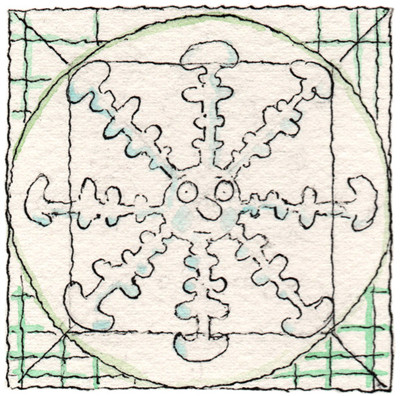Q. Why are snowflakes usually perfectly symmetrical? How does one arm “know” how the other arms are growing?
问:为什么雪花通常完全对称?其中一瓣怎么“知道”其他几瓣在怎么成长呢?
A. “The growth of a snowflake is sensitive to its immediate environment, especially the temperature and humidity,” said Kenneth G. Libbrecht, chairman of the physics department at the California Institute of Technology, who maintains a website explaining snow crystals. “It might take a half-hour for the crystal to reach its final size, and during that time it could travel a mile or more, experiencing ever-changing conditions.

答:“雪花在形成过程中对周围环境非常敏感,特别是温度和湿度,”加州理工学院物理系主任肯尼思·G·利布雷希特(Kenneth G. Libbrecht)说。他开设了一个网站,专门解释雪晶。“雪晶大概需要半个小时才能最终形成,在那段时间里,它能飞行一英里多,经历不断变化的环境。”
“If you look at an individual arm, its shape reflects the exact history of its travels,” he said. “But the six arms all travel together, so they all experience the same history. Thus they appear to grow in synchrony, even though no arm ‘knows’ how the others are growing.”
“如果你只看单独的一瓣,它的形状反映着自己的旅行历史,”他说,“但是这六瓣一起旅行,所以它们经历的历史是一样的。因此,它们似乎是同步成长,虽然哪一瓣也不知道另外几瓣在怎样成长。”
Dr. Libbrecht compared the process to going outside on a cold day, wearing a heavy coat and seeing everyone else wearing one as well, without foreknowledge or consultation.
利布雷希特把这个过程比作冷天穿厚外套出门,你会看到其他每个人也都穿着厚外套,但是没人能预见未来,也没人相互商量。
“The flip side of this story is that no two snowflakes follow exactly the same path in the turbulent atmosphere, and this is why no two snowflakes are exactly alike,” he said.
“这个故事的另一面是,在混乱的环境中,没有两片雪花的成长环境是完全相同的,所以不存在一模一样的两片雪花,”他说。
“Finally, snowflakes are in fact not usually perfectly symmetrical,” he said, “although snowflake photographers like to select the ones that are.” Large, beautifully symmetrical crystals are actually quite rare, he said, but “as with people, the most attractive snowflakes tend to get the most attention.”
“最后要说的一点是,实际上雪花并不总是完全对称,”他说,“不过,摄影者喜欢选择对称的雪花。”他说,美丽、对称的大雪晶实际上非常罕见,但是“最好看的雪花总是最引人注目。”


